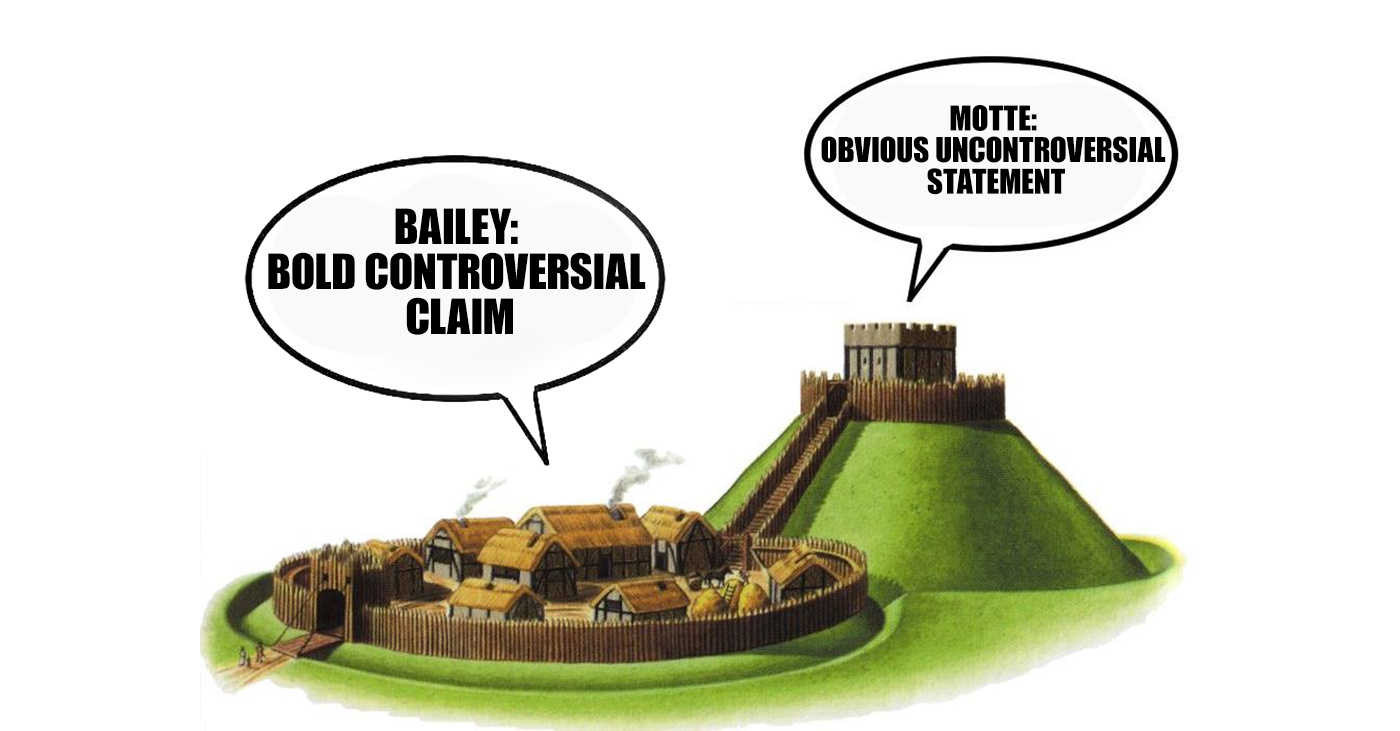8 logical fallacies that are hard to spot

Photo: Shutterstock
- A fallacy is the use of invalid or faulty reasoning in an argument.
- There are two broad types of logical fallacies: formal and informal.
- A formal fallacy describes a flaw in the construction of a deductive argument, while an informal fallacy describes an error in reasoning.
In arguments, few things are more frustrating than when you realize that someone is using bad logic, but you can’t quite identify what the problem is.
This rarely happens with the more well-known logical fallacies. For example, when someone in an argument starts criticizing the other person’s reputation instead of their ideas, most people know that’s an ad hominem attack. Or, when someone compares two things to support their argument, but it doesn’t make sense, that’s a false equivalency. But other fallacies are harder to spot. For example, say you’re arguing about politics with a friend, and they say:
“The far-left is crazy. The far-right is violent. That’s why the right answers lie the middle.”
Sure, it might be true that moderation is the answer. But just because two extremes exist doesn’t mean that the truth necessarily lies between those extremes. Put more starkly: If one person says the sky is blue, but someone else says it’s yellow, that doesn’t mean the sky is green. This is an argument to moderation, or the middle ground fallacy — you hear it a lot from people who are trying to mediate conflicts.
When you find yourself in arguments, it’s valuable to be able to spot and, if necessary, call out logical fallacies like this. It can protect you against bad ideas. Check out a few more examples of logical fallacies that can be tough to spot.
Appeal to privacy
When someone behaves in a way that negatively affects (or could affect) others, but then gets upset when others criticize their behavior, they’re likely engaging in the appeal to privacy — or “mind your own business” — fallacy. Examples:
- Someone who speeds excessively on the highway, considering his driving to be his own business.
- Someone who doesn’t see a reason to bathe or wear deodorant, but then boards a packed 10-hour flight.
Language to watch out for: “You’re not the boss of me.” “Worry about yourself.”
Sunk cost fallacy
When someone argues for continuing a course of action despite evidence showing it’s a mistake, it’s often a sunk cost fallacy. The flawed logic here is something like: “We’ve already invested so much in this plan, we can’t give up now.” Examples:
- Someone who intentionally overeats at an all-you-can-eat buffet just to get their “money’s worth”
- A scientist who won’t admit his theory is incorrect because it would be too painful or costly
Language to watch out for: “We must stay the course.” “I’ve already invested so much….” “We’ve always done it this way, so we’ll keep doing it this way.”
If-by-whiskey
This fallacy is named after a speech given in 1952 by Noah S. “Soggy” Sweat, Jr., a state representative for Mississippi, on the subject of whether the state should legalize alcohol. Sweat’s argument on prohibition was (to paraphrase):
If, by whiskey, you mean the devil’s brew that causes so many problems in society, then I’m against it. But if whiskey means the oil of conversation, the philosopher’s wine, “the stimulating drink that puts the spring in the old gentleman’s step on a frosty, crispy morning;” then I am certainly for it.
Note: If-by-whiskey really only becomes a fallacy when it’s used to conceal a lack of position, or to dodge a tough question. In Sweat’s speech, if-by-whiskey was an effective rhetorical device used to summarize two competing perspectives on alcohol, and to make his position clear.
RationalWiki provides an example of the usual format this fallacy takes:
“If by [noun], you mean [negative descriptors of noun], then of course [statement of lack of support/belief]. If, however, by [noun], you mean [positive descriptors of noun], then [statement of support/belief].”
Slippery slope
This fallacy involves arguing against a position because you think choosing it would start a chain reaction of bad things, even though there’s little evidence to support your claim. Example:
- “We can’t allow abortion because then society will lose its general respect for life, and it’ll become harder to punish people for committing violent acts like murder.”
- “We can’t legalize gay marriage. If we do, what’s next? Allowing people to marry cats and dogs?” (Some people actually made this argument before same-sex marriage was legalized in the U.S.)
Of course, sometimes decisions do start a chain reaction, which could be bad. The slippery slope device only becomes a fallacy when there’s no evidence to suggest that chain reaction would actually occur.
Language to watch out for: “If we do that, then what’s next?”
”There is no alternative”
A modification of the false dilemma, this fallacy (often abbreviated to TINA) argues for a specific position because there are no realistic alternatives. Former British Prime Minister Margaret Thatcher used this exact line as a slogan to defend capitalism, and it’s still used today to that same end: Sure, capitalism has its problems, but we’ve seen the horrors that occur when we try anything else, so there is no alternative.
Language to watch out for: “If I had a magic wand…” “What else are we going to do?!”
Ad hoc arguments
An ad hoc argument isn’t really a logical fallacy, but it is a fallacious rhetorical strategy that’s common and often hard to spot. It occurs when someone’s claim is threatened with counterevidence, so they come up with a rationale to dismiss the counterevidence, hoping to protect their original claim. Ad hoc claims aren’t designed to be generalizable. Instead, they’re typically invented in the moment. RationalWiki provides an example:
Alice: “It is clearly said in the Bible that the Ark was 450 feet long, 75 feet wide and 45 feet high.”
Bob: “A purely wooden vessel of that size could not be constructed; the largest real wooden vessels were Chinese treasure ships which required iron hoops to build their keels. Even the Wyoming which was built in 1909 and had iron braces had problems with her hull flexing and opening up and needed constant mechanical pumping to stop her hold flooding.”
Alice: “It’s possible that God intervened and allowed the Ark to float, and since we don’t know what gopher wood is, it is possible that it is a much stronger form of wood than any that comes from a modern tree.”
Snow job
This fallacy occurs when someone doesn’t really have a strong argument, so they just throw a bunch of irrelevant facts, numbers, anecdotes and other information at the audience to confuse the issue, making it harder to refute the original claim. Example:
- A tobacco company spokesperson who is confronted about the health risks of smoking, but then proceeds to show graph after graph depicting many of the other ways people develop cancer, and how cancer metastasizes in the body, etc.
Watch out for long-winded, data-heavy arguments that seem confusing by design.
McNamara fallacy
Named after Robert McNamara, the U.S. secretary of defense from 1961 to 1968, this fallacy occurs when decisions are made based solely on quantitative metrics or observations, ignoring other factors. It stems from the Vietnam War, in which McNamara sought to develop a formula to measure progress in the war. He decided on bodycount. But this “objective” formula didn’t account for other important factors, such as the possibility that the Vietnamese people would never surrender.
You could also imagine this fallacy playing out in a medical situation. Imagine a terminal cancer patient has a tumor, and a certain procedure helps to reduce the size of the tumor, but also causes a lot of pain. Ignoring quality of life would be an example of the McNamara fallacy.
Language to watch out for: “You can’t measure that, so it’s not important.”





